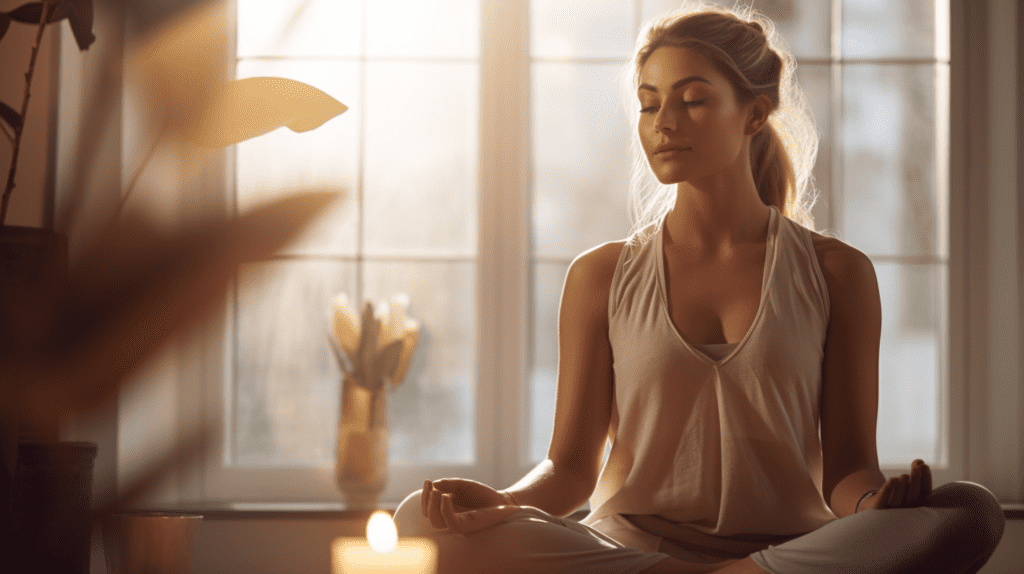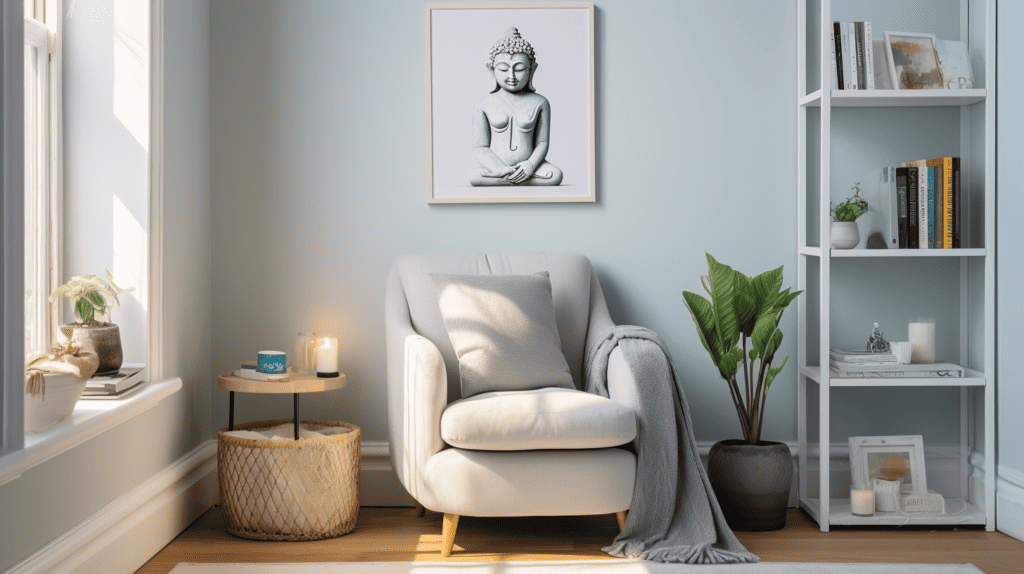Vipassana meditation for beginners promises a profound transformation of our fundamental reality if practiced correctly. But what defines it, and how does it rewire the mind? Years ago, at my first vipassana retreat, I discovered how repeatedly witnessing subtle body sensations with mindful equilibrium unravels your conditioned identity. Everything felt interconnected and devoid of solidity. Patient awareness decimated my ego structures and instilled incredible peace, wisdom, and compassion.
In this complete guide, I’ll teach you everything about this ancient practice – how to start sitting correctly, training concentration and equanimity daily, what intensive retreats entail, navigating difficulties, the transformative effects of insight meditation, and the historical Buddhist origins of vipassana. By exposing both the theory and tangible instructions exemplified through my human experience, the mystery behind this liberating practice unravels. Are you ready to discover reality’s secrets and awaken beyond self-limiting boundaries? Then, let’s begin the inner journey!
Key Takeaways
- Observing changing bodily sensations to understand impermanence
- Non-judgmental equanimous awareness of pleasant/unpleasant feelings
- Deepening concentration by anchoring attention on present moment
- Insight into the empty nature of phenomena erodes egoic patterns
- Retreats intensify direct seeing beyond conceptual overlay
- Daily practice integrates insights improving wellbeing
- Compassion towards oneself and others naturally increases
An Introduction to Vipassana Meditation
Vipassana meditation is an ancient Buddhist technique for gaining insight into the true nature of reality. It involves observing sensations in the body with equanimous awareness to understand impermanence. Regular practice leads to concentration, wisdom and liberation.
Vipassana, meaning “to see things as they really are” in Pali, is a form of insight meditation focused on systematically observing physical sensations throughout the body. By patiently witnessing how sensations continuously arise and pass, concentration deepens, allowing experiential insight into impermanence. This erodes attachment and suffering, leading closer towards awakening.
I first learned this profound technique during a rigorous 10-day silent vipassana retreat 6 years ago. The demanding schedule involved waking up at 4 AM and meditating for around 10 hours daily! We started by simply feeling the process of breathing. But by sustained observation for days, reality dissolved into a flux of ephemeral sensations – tension, heat, vibration etc. My conscious experience was totally transformed through that intensive training. Now, I practice Vipassana for 30 mins daily which keeps me present.
In this comprehensive guide, I will share everything you need to start a Vipassana practice, from basic techniques for beginners to what long retreats involve based on my own experience. Join me in discovering this liberating path of insight!
How to Start a Vipassana Practice
Modern research confirms what meditators have known for millennia – that dedicated practice changes the brain’s neural pathways in positive ways. Studies show Vipassana reduces stress and boosts health. You can easily begin:
Set a timer for 10-15 minutes. Find a quiet space with minimal distractions. Sit on a chair or cushon with your back straight. Close your eyes and relax into stillness. Feel your natural breath entering and leaving the body. Focus precisely on those sensations with patient attention.
From thegreatupdraft.com, they suggest focusing on the up-and-down movement of the abdomen caused by breathing and labeling each movement mentally as “rising” and “falling”. They emphasize the naturalness of the breath and discourage intentionally deep or quick breathing.
Now, slowly expand awareness to physical sensations manifesting anywhere – perhaps tension in the shoulders, tingling in the hands or a feeling of heaviness. Without judging or manipulation, observe each sensation arise, change and pass away. Equanimously notice reality’s constant flux beneath concepts of solidity.
Whenever your mind wanders, gently return focus to breath and body with mindfulness. Practice daily, even for short periods. Over time concentration strengthens, allowing you to discover the three marks – impermanence, unsatisfactoriness and selflessness underlying existence according to the Buddha’s teaching.
The Basics of Vipassana: Mindfulness and Awareness
Vipassana meditation hinges on developing two connected mental faculties – mindfulness and awareness. Understanding these is key:
Mindfulness means remembering to keep placing your attention exactly on the chosen object like breath or sensations. It anchors you in present moment reality. Whenever distracted, mindfulness returns focus with patience.
Awareness refers to clear perception of objects arising in consciousness like thoughts, emotions or external sounds without grasping them. Awareness remains relaxed, impartially noticing the constant stream of life.
By training these two wings together through Vipassana practice, penetrative insight into reality’s constantly changing dance arises naturally according to the Buddha. Absorption in the present replaces endless mental commentary. Equanimity follows as attachment falls away.
Vipassana Meditation Techniques for Beginners
There are various ways to start Vipassana training before attending intensive retreats. Begin with one resonating technique then diversify later once concentration grows:
Anapanasati (Mindfulness of Breathing): Observing the breath entering/leaving the nostrils trains effortless concentration rapidly applicable in daily life.
Vedananupassana (Contemplating Feelings): Patient non-reactive awareness of pleasant/unpleasant/neutral sensations. This investigation exposes their ephemeral nature.
Kayanupassana (Body Scanning): Slow mental sweeps of the entire body from head to feet noting its changing mix of sensations.
I recommend veterans combine samatha-style one-pointed absorption with scanning pratice to accelerate penetrating insight. But any technique cultivated regularly unveils secrets of existential impermanence!
What to Expect from Your First Vipassana Retreat
While home practice is great, periodically deepening your contemplation of subtle sensations through multi-day silent retreats can rapidly sharpen concentration. Here’s what to expect:
You’ll commit to 8-12 hours of meditation daily including sits, walks and mindful meals. Speaking and eye contact is minimized to reduce distraction. Waking up very early around 4 AM, you dive straight into noting mind/body processes with precision. Exhausting but rewarding!
By the third day, ordinary consciousness dominated by surface perceptions starts dissolving as attention moves deeper into direct non-verbal awareness of ephemeral bodily energies. Phenomena becomes a play of vibratory sensations devoid of solidity when inspected microscopically. As incredible Equanimity and bliss may flood the mindstream upon touching this deathless element.
My first retreat was 10 days practicing the Mahasi Sayadaw style established by the influential 20th century Burmese master. We carefully labeled each experience from breath to itches to feelings as “rising/falling” with mindulness, exposing their impermanent nature. Profound stillness resulted by continuously seeing reality’s unfolding without ego.
Preparing for Your First 10-Day Retreat

Attending an intensive 10 day vipassana retreat can be intimidating for beginners but proper preparation facilitates profound insights:
Set Intention Clearly define your motivations – seek clarity on life goals, address unhelpful patterns or resolve to penetrate deeper facets of reality beyond concepts.
Know the Timetable – Waking at 4 AM for the early sit until around 9 PM with scheduled meals, breaks, exercise and dharma talks. Continuously apply effort!
Prepare Family & Friends – Let loved ones know you will be completely inaccessible to reduce worries over being disconnected. Some centers store devices.
Review Techniques – Study instructed methods like labeling or body scanning to start uninterrupted practice immediately upon entry into the strict retreat container.
Entering prolonged silence to turn attention relentlessly inwards requires courage. Yet fruit ripens through properly directed efforts. Trust the universal process and surrender fully!
Learning to Observe Physical Sensations
Noticing subtle bodily sensations is central to Vipassana practice. But what defines sensations and how to observe them?
Sensations refer to tactile experiences continuously sparkling inside awareness – tension, tingling, pain, temperature changes etc. Thoughts and external phenomena manifest as sensations when appearing cognitively. Meditators talk of an endless flux of ephemeral phenomena.
Practice starts by systematically scanning sections of your body to detect this living matrix of sensations devoid of verbal labels. Wherever attention fixes due to pleasant/unpleasant sensations arising, sustain focus microscopically investigating how they self-liberate each moment. This builds concentration power.
Reactive desire for “good” sensations or aversion towards “bad” ones causes suffering according to the Buddha. Therefore develop equanimity and mindfulness to impartially observe all temporary bodily energies with wisdom. This penetrating insight deconstructs egoic patterns tied to sensation. Clear awareness alone remains!
Concentration, Wisdom and Ethics
Classical Buddhism integrates three vital principles for complete awakening – concentration samadhi, wisdom panna and ethical conduct sila. Applying this framework keeps vipassana practice wholesome:
- Samadhi means unifying attention so it effortlessly settles on the meditation object without wavering. Concentrative stillness calms restlessness opening space for nuanced insight.
- Panna refers to experiential wisdom gained by penetrating three characteristics of phenomena – impermanence, unsatisfactoriness and non-self through concentrated awareness. This erodes ignorance.
- Sila means adopting principled behavior based on non-harming to establish a moral foundation for practice. Virtue brings joy and self-respect which support meditation.
I have realized training each of these pillars through different techniques counterbalances limiting tendencies:
Over-concentration can cause dullness. Excessive analysis without tranquility causes distraction. Disregarding ethics may increase doubt. But emphasizing insight while nurturing stillness and virtue brings harmony.
Overcoming Difficulties
Temporary obstacles inevitably arise when first learning Vipassana but self-compassion helps overcome them so you persist accessing liberating insight:
Distraction – The restless mind compulsively grasps stimuli. Patiently return to your object without frustration. Distraction itself can be an anchor! Practice non-judgment.
Fatigue & Dullness – Yawning and heavy eyes signals low energy. Adjust posture, gently stretch the body or splash cold water on your face. Change techniques. Observe the thinking itself.
Impatience & Boredom – Common causes are excessive striving and dullness. Relax efforts while staying alert. Don’t force concentration. Allow it to naturally settle while energizing the mind.
Discouragement – Doubting progress or feeling hopeless causes striving which inhibits concentration. Ups and downs are normal! Inspiration returns by appreciating small steps. Your learning continues through practice. Have faith!
According to the Buddha, suffering is perpetuated mentally through craving, aversion and delusion. With wisdom and endurance, you can transcend these by embodying equanimity towards all changing phenomena.
Integrating Vipassana into Daily Life

While occasional retreats intensify insights, establishing a daily vipassana routine ensures you actualize spiritual fruits long-term. Here are some key principles:
- *Create a consistent schedule – *Practice at least once but ideally twice daily by making it an unshakable habit. I sit after my morning yoga and mid-evening. Starting small is key – even 10-15 minutes daily.
- Record sessions – Apps like InsightTimer track sit lengths. Noting emotional tone afterwards reveals personal patterns to understand oneself better. Become your own spiritual scientist!
- Change techniques – Alternate between mindfulness of breath, bodily sensations, chanting or metta while emphasizing sensation observation to realize impermanence.
- Optimize space & environment – Choose a quiet, clean space with minimal distractions. The posture should be erect but without strain. I actually prefer kneeling which keeps me alert!
Dedicate focused periods for formal sitting, then maintain innate awareness during daily tasks perceiving reality’s constant flux. Whatever approach you adapt, emphasize investigating sensations which rapidly penetrates the deepest spiritual truths according to the Buddha’s teaching!
The Transformative Effects of Vipassana
Why stress fully establishing awareness of impermanence in Vipassana? Because contacting the unconditioned opens pathways causing the activity of ego to entirely dissolve according to the Buddha. This forever changes consciousness:
The classical attainment of “Stream Entry” (Pali: Sotapanna) signals the initial breakthrough whereby one gains unshakeable insight into the deathless, boundless nature of mind and reality which cannot be conceptualized.
Suddenly realizing firsthand that all phenomena lack inherent existence can permanently cut accumulated “lifetimes” of delusion tied to a separate self as limitless wisdom replaces narrow identification. Suffering ends as immeasurable compassion towards all beings blossoms, reflecting clearly what already is.
While lifetimes of ego patterning inevitably contain residues, sustaining vipassana meditation continually loosens habit energies catalyzing a positive feedback loop of expanding mindfulness, concentration and liberation. You touch timeless peace in the deepest states of meditative absorption.
Outwardly, activities express spontaneous skillful ease. Once tasting utter freedom beyond space and time during seasons of intensive practice, resting as luminous awareness continues effortlessly as inner/outer boundaries dissolve. This Holy Life utterly transforms every atom of one’s existence!
Vipassana vs Other Forms of Meditation
Vipassana is contrasted with other Buddhist meditations aiming for mental purification and awakening. While techniques differ, the goal of penetrative insight remains essential:
Samatha (Calm Abiding) develops intensive single-pointed concentration by suppressing five hindrances – craving, aversion, dullness, restlessness and doubt. This leads to serene states (jhanas). But penetrating insight is lacking.
Vajrayana Visualization uses elaborate visualized images of deities, mandalas, seed-syllables and energy channels/winds as the meditation object. This harnesses creative imagination for spiritual breakthoughs. But formless insight is not the focus.
Dzogchen starts with relaxing into pure non-conceptual presence beyond all effort and technique. Allowing the natural primordially pure essence of mind to reveals itself. No method supports this. Insight into the base state is instant.
Zen Koan Introspection contemplates irrational phrases like “what is the sound of one hand clapping?” to exhaust mental faculties and spark intuitive insight. Koans transcend duality. But methodical insight into phenomena is absent.
While techniques differ due to varied historical contexts, all schools of Buddhism acknowledge insight into the three marks – impermanence, suffering and non-self as vital for uprooting delusion. Sustained Vipassana meditation focuses directly on this penetration by observing reality’s constant flux.
As a Vipassana practitioner, I value this diversity of skillful means while recognizing the immense transformative power of patient investigation into the essentially empty, ephemeral nature of phenomena. Continuous mindfulness and equanimity towards changing body sensations unifies mind and reality. Suffering ceases as one recognizes the luminous ground of Being in all experiences.
The History and Origins of Vipassana
Vipassana’s origins extend back to the historical Buddha himself who emphasized direct seeing through meditative insight. But various traditions arose in different regions and eras:
Buddha Shakyamuni, born in 6th century BCE India synthesized ancient yogic practices into systematic mindfulness and absorption techniques for awakening by penetrating dynamics of mind/body processes supported by wisdom & ethics.
These methods spread throughout Asia over centuries along spice and silk trade routes into diverse cultures birthing new Buddhist schools like Tibetan, Chinese, Korean and Japanese – each with unique expressions like Tantra, Pure Land and Zen but all aimed at realization of mind’s luminous nature beyond ego.
In the 19th century, the Burmese monk Ledi Sayadaw pioneered modern vipassana by teaching rigorous and extensive satipaṭṭhāna insight meditation to laypeople in addition to monastics. His student Mahasi Sayadaw later established the gold-standard technique and retreat style which defines contemporary vipassana globally today.
Influenced by both their Burmese revolution and Goenka’s grassroots teaching approaches, dozens of influential Western lay teachers like Jack Kornfield, Sharon Salzberg, Joseph Goldstein and Ajahn Sumedho successfully spread vipassana worldwide as interest in Buddhism’s psychological insights exploded since the 1970s. Now millions practice!
While techniques adapted into unique forms as influences fused, the essential pillars of ethical conduct, concentrative mastery and direct insight into impermanent reality remains vipassana’s living heart indebted to the Buddha’s profound awakening over 2500 years ago which continues inspiring seekers worldwide towards inner peace and compassionate service.
The Goals and Benefits of Vipassana Meditation
Systematically cultivating awareness of changing body sensations may seem abstract. But Siddhattha Gotama, the historical Buddha himself, affirmed this method’s power for reducing mental toxins and unlocking wisdom underpinning happiness itself. What core goals and fruits manifest?
1. CONCENTRATION – By anchoring attention mindfully on continuously arising and passing bodily/mental phenomena without distraction or grasping, one-pointed unification of mind known as samadhi or dhyana naturally results. This induces refreshment while empowering insight.
2. EQUANIMITY – Impartially observing the endless dance of pleasant/unpleasant sensations without identifying with them loosens egoic patterns of desire and aversion. You abide calmly amidst life’s pleasurable/painful changes as they self-liberate.
3. INSIGHT – Patient investigation penetrates the empty core within all phenomena – their ephemeral, substanceless nature behind concepts of solidity and permanence. This profound realization of impermanence, suffering and non-self sparks awakening. Samsara ends!
4. COMPASSION – With penetrating insight into the changing, essenceless nature of embodied experience comes surrendering limited self-reference and resting in natural awareness beyond separate identity. One’s behavior exudes wise empathy.
Whatever personal motives initially draw you to practice Vipassana meditation – reducing stress, boosting focus or addressing unhelpful mental patterns, actualizing these universal fruits results from sincere application according to Buddhist contemplatives across traditions, historical eras and diverse cultures. Why not experiment and discover for yourself?
Conclusion on Vipassana Meditation for Beginners
Whatever your motivations for exploring this profound path are, regular Vipassana training unquestionably shapes one’s nervous system, mindset and conscious lens in positive ways according to thousands of years of cumulative evidence. Why not experiment beyond beliefs and directly experience the truths so many contemplatives speak of? The journey begins now!
FAQ on How To Practice Vipassana
Q: What are the types of meditation I can practice at home?
A: There are various types of meditation techniques you can practice at home such as Mindfulness Meditation, Zen Meditation, Vipassana (“special seeing”), and Transcendental Meditation. However, if you’re looking for a deeper understanding of mind and body, it’s recommended to choose “vipassana” or insight meditation which stems from the traditions of buddhist meditation.
Q: I’m learning more about vipassana. Can I perform this type of meditation at home?
A: Absolutely! You can definitely practice Vipassana meditation at home. It’s important to choose a quiet place where you will not be disturbed to support your meditation practice. Moving your attention inward promotes awareness and equanimity. Remember, consistency is key in mediation.
Q: Can you explain the concept of ‘rising and falling’ in vipassana meditation?
A: Sure. In vipassana meditation, ‘rising and falling’ refers to the practice of being aware of your breath. You learn to notice how the breath rises and falls, and this continuous attention builds focus and equanimity.
Q: Is there any specific course I can follow to become more aware of vipassana practices?
A: Yes, you can consider taking a 10-day vipassana course. These are immersive retreats which focus primarily on vipassana meditation practices. They generally provide a more structured approach towards learning more about vipassana.
Q: How often and for how long should my meditation practice be?
A: If you’re a beginner, it’s recommended to start with 10-20 minutes of meditation practice a day, gradually lengthening the time. Persistence and consistency are vital to experience the benefits of meditation. As far as frequency is concerned, daily practice may bring the most substantial results.
Q: What is the main difference between mindfulness and vipassana?
A: While both types of meditation aim at cultivating awareness and clarity, mindfulness focuses on being present in the moment, whereas, vipassana is about “seeing things as they really are” through sustained attention and insight.
Q: How do I know if I’m doing vipassana right?
A: Vipassana meditation is about becoming aware of everything happening in your mind and body without reacting. You’re doing it right as long as you’re persistent, patient, and not forcing anything. Seeing things with a “special seeing”, referring to seeing things as they truly are, is at the core of the practice.
Q: Can I use a meditation app to support my vipassana practice?
A: Yes, using a meditation app can be a useful tool, especially if you’re a beginner. These apps often offer guided instructions and reminders that can assist in keeping your meditation practice consistent. However, remember that an app should only be a tool to aid your practice, and the real focus should be on your own awareness and equanimity.
Q: Where can I learn more about the benefits of vipassana meditation?
A: There are many online resources, books, and courses available that provide more information about the benefits and techniques of vipassana. You may also seek out meditation teachers in your local area or online who can provide personal guidance.
Q: What should I expect during a 10-day vipassana course?
A: The 10-day vipassana courses are intense, focusing on personal transformation through self-observation. It involves silent meditation, daily discourses, and self introspection. You can expect to further your meditation in general, while deepening your understanding and experience of vipassana.





Leave a Reply